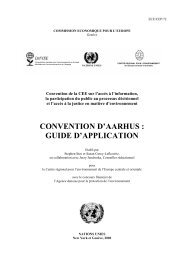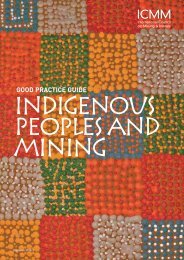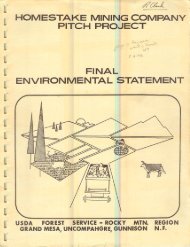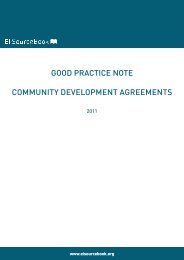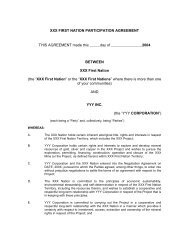Sharing Mining Benefits in Developing Countries - World Bank
Sharing Mining Benefits in Developing Countries - World Bank
Sharing Mining Benefits in Developing Countries - World Bank
Create successful ePaper yourself
Turn your PDF publications into a flip-book with our unique Google optimized e-Paper software.
Table 3.4: Highly Participative Governance StructuresStrengthsCreates benefi ciary ownership,enhanc<strong>in</strong>g relevance, effectiveness,and susta<strong>in</strong>ability of foundationProvides a means of hold<strong>in</strong>gbenefi ciaries accountable, particularlyif they participate <strong>in</strong> decision mak<strong>in</strong>gProvides local stakeholders witha voiceMay provide enhanced opportunitiesfor seek<strong>in</strong>g external fi nanc<strong>in</strong>gWeaknessesCan result <strong>in</strong> conflict<strong>in</strong>g agendas andpriorities on govern<strong>in</strong>g bodyOften requires more time to buildcapacity and ensure that communityparticipation is effectiveL<strong>in</strong>k to company or governmentobjectives can be dilutedCan be more expensive <strong>in</strong> theshort termInfluence of the <strong>M<strong>in</strong><strong>in</strong>g</strong> Company<strong>M<strong>in</strong><strong>in</strong>g</strong> companies have established the majority of the FTFs <strong>in</strong> existence<strong>in</strong> the m<strong>in</strong><strong>in</strong>g <strong>in</strong>dustry (BSR 2010). The decision to establish anFTF often rests with the company, as does the level of <strong>in</strong>fluence that thecompany will exert over the day-to-day operation and direction of theFTF. That level of <strong>in</strong>volvement can vary significantly and is moderatedthrough the follow<strong>in</strong>g broadly def<strong>in</strong>ed avenues for participation <strong>in</strong> theFTF’s structure:• FTF design. Decid<strong>in</strong>g on the structure and design of an FTF througha collaborative process that engages a wide range of stakeholders canprovide a solid basis for an FTF. Depend<strong>in</strong>g on the size of the stakeholdergroup and the group’s experience with FTF structures <strong>in</strong> thepast, participation of this form can be time-<strong>in</strong>tensive, thus limit<strong>in</strong>g theapplication of this approach <strong>in</strong> situations where a company or governmentneeds to deliver development benefits speedily.• Governance. FTF governance, at its simplest, can be described by themembership of the board of directors or trustees. The level of participation<strong>in</strong> the governance structure can be adjusted through the <strong>in</strong>clusionof stakeholder representatives from groups other than the own<strong>in</strong>gentity. It should be noted that there is a difference between participationand representation. Expand<strong>in</strong>g the representativeness of a govern<strong>in</strong>gbody is also likely to have an impact on the level of control exertedover the FTF by the owner.• Project generation. Regardless of whether the FTF employs a grantmak<strong>in</strong>gor operational approach, projects can be generated <strong>in</strong>ternally,30 <strong>Shar<strong>in</strong>g</strong> <strong>M<strong>in</strong><strong>in</strong>g</strong> <strong>Benefits</strong> <strong>in</strong> Develop<strong>in</strong>g <strong>Countries</strong>



